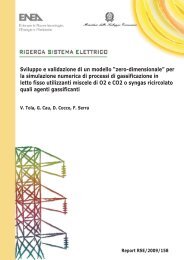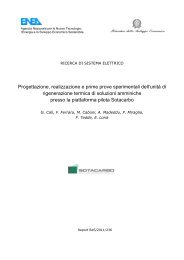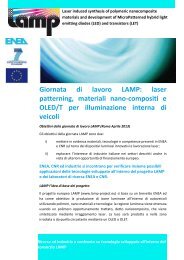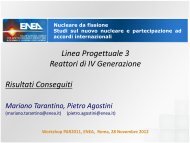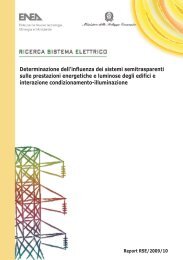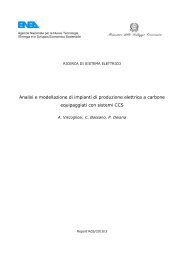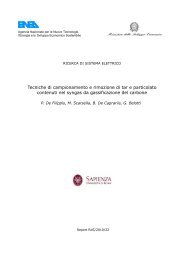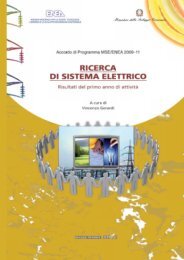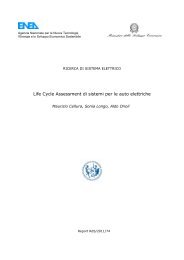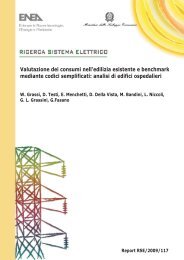Sviluppo di moduli batterie litio-ioni per avviamento - Enea
Sviluppo di moduli batterie litio-ioni per avviamento - Enea
Sviluppo di moduli batterie litio-ioni per avviamento - Enea
You also want an ePaper? Increase the reach of your titles
YUMPU automatically turns print PDFs into web optimized ePapers that Google loves.
Specifiche della cella 3,65V - 20Ah<br />
Tensione nominale 3.65 V<br />
Capacità nominale 20 Ah<br />
Dimens<strong>ioni</strong> terminali esclusi (L x W x H) 216 x 130 x 7.2 mm<br />
Peso 0.425 kg<br />
Energia specifica 175 Wh/kg<br />
Densità <strong>di</strong> energia 370 Wh/l<br />
Scarica<br />
Standard<br />
@ +23 °C<br />
Carica<br />
Standard<br />
@ +23 °C<br />
Max corrente continuativa 100 A<br />
Max corrente pulsante 10 sec. 200 A<br />
Tensione limite raccomandata 3.0 V<br />
Cut – off 2.5 V<br />
Tensione 4.15 V<br />
Corrente raccomandata 10 A<br />
Tempo <strong>di</strong> carica 2.5 h<br />
Resistenza interna 3 mΩ<br />
Tem<strong>per</strong>atura <strong>di</strong> esercizio -30 °C ÷ +50 °C<br />
Tem<strong>per</strong>atura <strong>di</strong> storage -30 °C ÷ +50 °C<br />
Specifiche del pacco 48V – 20Ah<br />
Tensione nominale 46.8 V<br />
Capacità nominale 20 Ah<br />
Dimens<strong>ioni</strong> (L x W x H) 282 x 153 x 166 mm<br />
Peso 8.90 kg<br />
Energia specifica 105 Wh/kg<br />
Densità <strong>di</strong> energia 130 Wh/l<br />
Scarica<br />
Standard<br />
@ +23 °C<br />
Carica<br />
Standard<br />
@ +23 °C<br />
Max corrente continuativa 60 A<br />
Max corrente pulsante 10 sec. 100 A<br />
Tensione limite raccomandata 39.0 V<br />
Cut – off 32.5 V<br />
Tensione 53.90 V<br />
Corrente raccomandata 20 A<br />
Tempo <strong>di</strong> carica 1.5 h<br />
Tem<strong>per</strong>atura <strong>di</strong> esercizio -30 °C ÷ +50 °C<br />
Tem<strong>per</strong>atura <strong>di</strong> storage -30 °C ÷ +50 °C<br />
Tabella 29 - Specifiche della cella 3,65V – 20Ah e del pacco 48V – 20Ah<br />
Si noti come le prestaz<strong>ioni</strong> del sistema, soprattutto in termini <strong>di</strong> corrente erogabile durante la<br />
fase <strong>di</strong> scarica, siano inferiori a quelle della singola cella: ciò è dovuto alle <strong>di</strong>fferenti con<strong>di</strong>z<strong>ioni</strong><br />
<strong>di</strong> smaltimento del calore, la cella singola smaltisce il calore meglio <strong>di</strong> quando viene <strong>di</strong>sposta<br />
all’interno <strong>di</strong> un case insieme ad altre celle <strong>per</strong> formare un modulo o pacco.<br />
Il BMS<br />
Il BMS protegge e bilancia le celle, misura lo stato <strong>di</strong> carica, realizza la gestione termica e<br />
monitora l’intero sistema <strong>batterie</strong>, ottimizzandone l’esercizio in sicurezza ed efficienza. In caso<br />
<strong>di</strong> anomalia, il BMS <strong>di</strong>sconnette il sistema <strong>batterie</strong> comandando l’a<strong>per</strong>tura <strong>di</strong> un relè <strong>di</strong> tipo<br />
elettromeccanico.<br />
81



